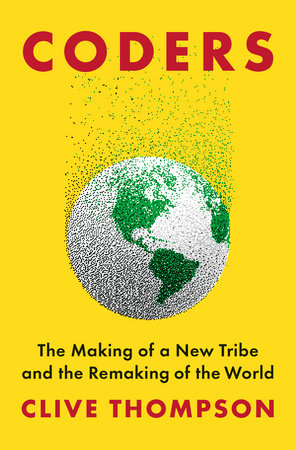Book Review: “Coders” — Brave New World, Coded
By Steve Provizer
Coders had nothing in their intellectual toolbox that would help them understand people.
Coders: The Making of a New Tribe and the Remaking of the World by Clive Thompson. Penguin Random House, 448 pages, $28.

As a culture, we have had few serious public discussions about the impact of new technologies. That might be because of our naïve, even Pollyanna-ish, view of the notion of “progress.” We are content to ask a few simple questions: Will it make my life easier? Will it positively impact my income? Will it amuse me in new ways? Of course, these are reasonable questions, but they don’t address how new technology is transforming our inner lives as well as our relationships to others.
At this late point in technology’s evolution, in-depth discussions of its impact may seem too little, too late. We are so in thrall to “smart” devices and Artificial Intelligence (AI) that, unless or until the effects of catastrophic weather events or war decimate our technical infrastructure, we will continue to cede power to our computer masters. Unless you have the rare skill set and/or the necessary determination to carve out a life that’s off the grid, we apparently have no alternative but to live a life increasingly dominated by technology, an existence increasingly governed by algorithms and code.
As Oliver Hardy said to Stan Laurel: “This is another fine mess you’ve gotten me into.”
The author of Coders, Clive Thompson, who writes for Wired and other publications, is not as pessimistic about what is happening as I am. Using a clear, mostly compelling, and fairly neutral tone, he describes where we find ourselves today. Mixing personal stories with broader history, he presents a thumbnail history of coding, from its early days in the 1950’s to the present. This is a past rife with irony. Among the first ironies: women made up the initial wave of programmers. They were ceded these jobs because the male computing engineers considered dealing with the hardware — the large computers like ENIAC — the more important work and were content to leave the “mundane” task of programming the machines to women.
Then, by the late ’60s, corporations realized the importance of programming and that structurally, they needed to promote coders to management positions. “It didn’t feel right to be putting women into such important positions,” writes Thompson. Plus, the higher pay was drawing more people with advanced degrees — and these were almost all men. He cites 1984 as a key year in this process of gender change. More computers began to be available for home use. Families tended to provide computers to sons rather than daughters; dads bonded with their sons on the machines, not their daughters. Women began to be branded as psychologically unsuited for the work; a premise that Thompson thoroughly decimates.
In truth, sexism and racism have been endemic in the software industry since its beginning. Charges of sexual harassment within the industry were not treated seriously. The male coding cohort, as you might surmise, was white and mostly from privileged backgrounds. Thompson explores the psychological makeup of this group and the propagation of the myth of the world of coding as a “meritocracy.” Apart from self-congratulations, the concept provided an after-the-fact rationalization of inequity while it justified the industry’s exclusion of minorities and women. The Western mythology of meritocracy did not extend to countries like India and Malaysia, where parents encouraged their daughters, who then became coders in much higher percentages than did women in the U.S.
Thompson explores how this all-boy’s environment generates the problems we’ve been seeing with harassment and hate speech on Twitter, Facebook, and other online forums. He ascribes no particular bad intent to the coders, but argues that, given their privileged male status, they could not anticipate harassment problems that they themselves never encountered. Thompson does not believe that this excuses them or the industry, but examines a variety of other explanations, other than class-ism and sexism, for the misbehavior.
Technology’s enormous capacity for scale has infested Facebook, Google, and other Silicon Valley kingpins with a lust for international domination. Venture capitalists are eager to fund only projects with enormous potential for global-wide adoption. So, in order to attract those monies, startups have to be launched as free to use, in order to gather up masses of users. The next logical step of the business model is to begin selling ads. Thompson observes: “So you begin building in as many psychological lures as possible into your code.” Instead of asking ‘what should we be making, engineers ask ‘what will help the system grow fastest?’ Given this premise, the goal becomes to create algorithms that reward content that triggers strong emotions and inspires clicks. Thus inflammatory material rules and, ultimately, paves the way for the debilitating ideological echo-chambers we are now trapped in. Author Siva Vaidhyanathan puts the quandary this way: “Facebook does not favor hatred. But hatred favors Facebook.”
Unfortunately, the psychological makeup of the coding cohort disposed them to ignore the human ramifications of what they were doing. Asserts Thompson: “Coders had nothing in their intellectual toolbox that would help them understand people.” He quotes Tom Lehrer’s song about Werner Von Braun: “Once the rockets are up, who cares where they come down? That’s not my department.”

Clive Thompson, author of “Coders.”
One alternative to this approach that Thompson describes is the archaic notion of asking people to buy your product. This calls for a transparency, a dedication to the service aspect of the software, that an ad-based approach doesn’t. Coder David Heinemeier Hansson started a software company operating on this premise and he says: ”When your customers are paying you money, you can actually call them customers and not users, which is a term from drug-dealing.”
Thompson provides a pretty thorough picture of the current state of Artificial Intelligence (AI), painting a picture of a field that teeter totters between successes and failures. AI can exist only when massive amounts of data are fed into the program to “train” it. The result, as engineers (and recording musicians) say: shit in, shit out. AI photo identification of white people is very accurate, but those programs have labeled black people as “gorillas.” Typing in “Are Jews” in one program resulted in a top entry of “Are Jews evil?” Racially negative text allusions to Mexicans resulted in Mexican restaurants being rated lower than other ethnic restaurants. Men are given higher paying jobs at job sites than women are. Some judges rely on an AI program called COMPAS to make decisions about sentencing, parole, or treatment. The intent is to speed up the judicial process. Alarmingly, a Propublica study says that COMPAS was almost twice as likely to give a black defendant a high-risk recidivist score, even though it was claimed that the study was mindful of prior crimes, age, and gender. The result: longer sentences and fewer paroles.
There’s a school of people in the industry who say that adjusting AI programs to avoid racist elements is inefficient, inelegant, and presents a false picture of reality. Robin Speer, who develops AI programs, disagrees: “Designing any AI system involves moral choices. And if you try not to make those moral choices, you’re still making moral choices.”
Further muddying the waters. The computer scientists who create AI programs know they are venturing into the unknown. They are creating certain kinds of computer structures, priming the pump by feeding in massive amounts of data, yet they can’t explain how or why AI actually works. It’s a black box.
At the end of the book Thompson paints a slightly more optimistic picture about where things are going. He notes that Google employees en masse protested Google’s contract to provide AI for military drones, forcing the company to withdraw from the project. (He writes that fear of losing important coders is what made Google take their concerns seriously.) He cites a program in Kentucky that successfully teaches former coal miners how to code and notes that “bootcamps” have sprung up that may have the effect of potentially diversifying the coder cohort. Predictably, as the diverse newbies move into jobs in the industry, there seems to be a trend to put them in lower paid “front-end” work. Thompson quotes educator/ coder Miriam Posner on the dilemma: “Feminized jobs are less prestigious.” Thompson adds: “Once a specialty — nursing, elementary school teaching — becomes dominated by women it’s looked down upon (subtly or openly) and confers lower status and lower pay.”
Coders will be of interest to anyone trying to come to terms with the ramifications of the forces that are surrounding and permeating our lives: algorithms, coding, and an ever-mounting number of intrusive, data-hungry devices. Thompson proffers no easy answers, but it is useful to see the fix we are in so clearly delineated.
Steve Provizer writes on a range of subject, most often the arts. He is a musician and blogs about jazz here.

[…] York Times Book Review Kirkus Reviews Book Review The Arts Fuse Book Review Publishers Weekly Book […]
[…] York Times Book Review Kirkus Reviews Book Review The Arts Fuse Book Review Publishers Weekly Book […]